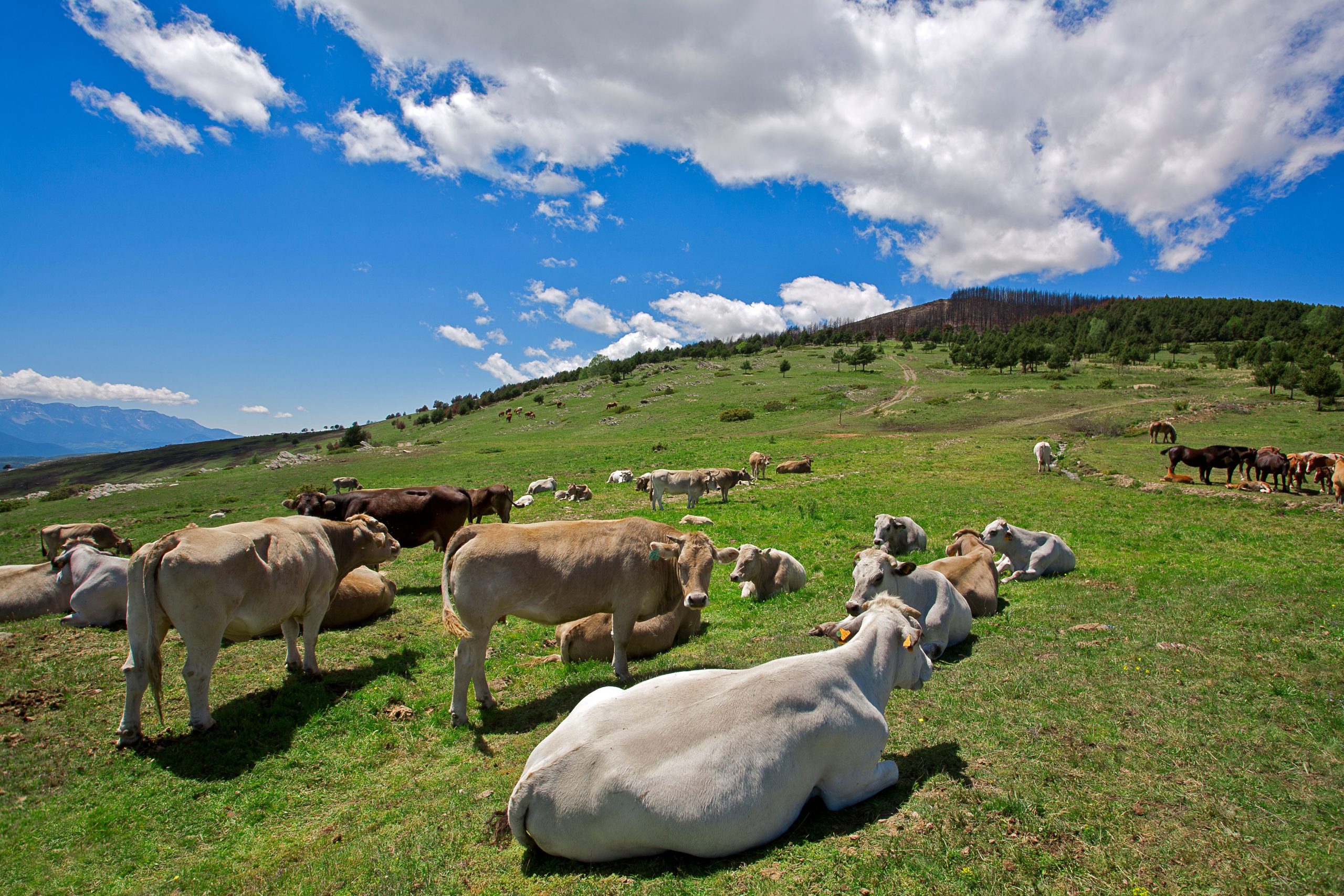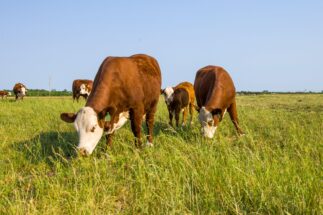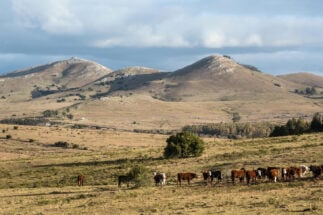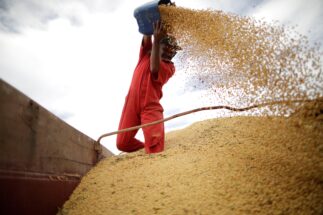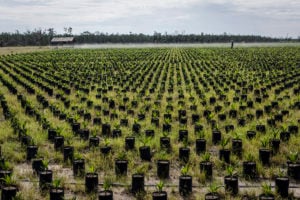“Regeneration” is a buzzword in the agriculture sector and beyond. It’s the subject of a Netflix documentary, Kiss the Ground, which centres on the UN’s projection that we may only have 60 years left of farming unless we can repair our degraded soil. And it’s the focus of a popular TED talk by Allan Savory, a farmer from Zimbabwe, that has attracted over 7.8 million views.
There is, however, no agreed definition for “regenerative agriculture”. In fact, one study of the term’s usage in academic articles found that half of the papers reviewed failed to supply a definition. But, in short, regenerative agriculture encompasses a set of farming and grazing practices that, among other benefits, can help tackle climate change by restoring degraded soil biodiversity and rebuilding soil organic matter.
Globally, industrial agriculture is a key driver of land use change – especially in biodiversity hotspots such as the Amazon basin – and its intensive practices increase soil degradation, with around a third of the world’s soil considered moderately to highly degraded. Food production is also associated with 37% of global greenhouse gas emissions.
Regenerative farmers typically disturb the soil as little as possible. They forgo tillage – the turning and preparation of soil – as it alters the complex network of soil biodiversity, and also avoid using large doses of pesticides. They look to grow a diversity of crops, instead of just monocultures, and believe that grazing animals are vital to the improvement of soil health.
15million
hectares of land are currently farmed using regenerative methods, according to Savory Institute estimates
Interest in regenerative agriculture spans across different sectors, from public to private as well as NGOs. The Savory Institute, created by Allan Savory, works to disseminate knowledge on its practices and promote their adoption, with branches all across Latin America. There are even certification programmes offered by the Savory Institute and the Regenerative Organic Alliance.
Top-level acknowledgement of regeneration’s potential benefits has also increased. In its recent Special Report on Climate Change and Land, the UN’s Intergovernmental Panel on Climate Change (IPCC), described regenerative agriculture as a “sustainable land management practice” focused on ecological functions that “can be effective in building resilience of agro-ecosystems”.
How does regenerative agriculture work?
Regenerative agriculture is a method of farming that “improves the resources it uses, rather than destroying or depleting them,” according to the Rodale Institute, one of the growing number of organisations advocating this approach. A great deal of emphasis is placed on looking holistically at the agro-ecosystem, with a variety of techniques being employed.
In conventional farming, soil is often dug up and left bare after harvest. Tilling and ploughing erodes the soil, depriving it of its nutrients and releasing large amounts of carbon dioxide (CO2). By adopting no-till practices, farmers can reduce physical disturbance to the soil, maintaining its overall structure and also preventing erosion.
Regenerative systems also increase the fertility of the soil by planting cover crops between seasons (such as wheat), employing crop rotations, and applying compost and animal manures, all of which restore the soil’s microbiome to promote nutrients. Synthetic fertilisers used in conventional farming have created imbalances in the structure and function of these microbial communities in the soil.
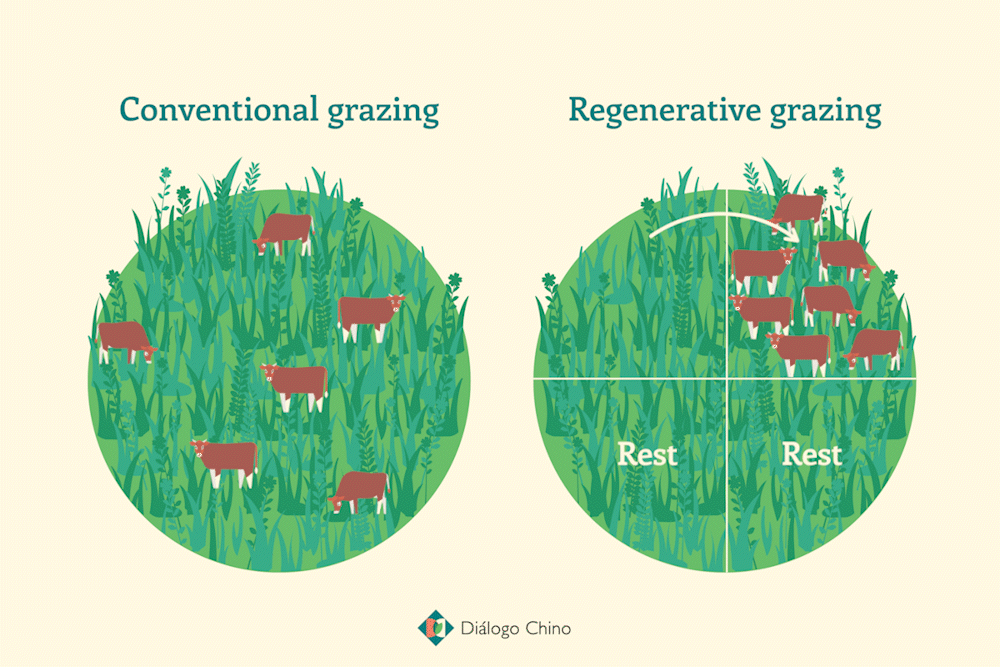
Then, there is the role of livestock. The way we have traditionally used cows on farms is not regenerative: animals kept in only one field over a long period of time will likely overgraze, eventually leaving soil bare and compacted. Instead, a regenerative approach focuses on moving animals through land to mimic traditional grazing patterns, leaving animals free to roam on much larger spaces before overgrazing can occur.
This technique, known as adaptive multi-paddock (AMP) grazing, uses high densities of livestock for short durations on a given area, before rotating the animals onto a different enclosure and repeating. This allows each paddock an extended period free from grazing, in order to induce accelerated grass growth.
Furthermore, cows break up the soil as they move their hooves, creating a natural mulch that can help retain moisture in the soil, though an AMP approach also helps to manage this, ensuring this does not cause excessive disturbance, and allowing soils periods of rest. Their excrement also adds nutrients to the ground, further increasing soil health.
The climate argument
A healthier soil means more CO2 is taken out, or sequestered, from the air, which is good news in terms of the climate crisis. Soil – or at least a healthy soil – contains a vast number of diverse microbes, which work in exchange with plants growing in the soil. Plants pull in carbon through photosynthesis, which they use to grow, and the excess carbon is transported to the soil, where it becomes organic matter.
This carbon feeds the fungi and various microbes in the soil, which in return supply the plants with the nutrients they need. It’s a perfect balance, but one which is disrupted by the methods of intensive conventional farming. By moving towards a regenerative approach, some of its proponents argue, the sector wouldn’t need to cut as many emissions as the soil would be capturing more CO2.

Project Drawdown, a climate NGO exploring and promoting solutions to climate change, argues that “regenerative agriculture enhances and sustains the health of the soil by restoring its carbon content, which in turn improves productivity – just the opposite of conventional agriculture.” They estimate that regenerative a could sequester between 14.5 and 22 gigatons of CO2 by 2050.
Nevertheless, estimates of the amount of CO2 that could actually be captured by soil carbon sequestration vary between experts. The World Resources Institute (WRI) claims that the feasibility of scaling regenerative agriculture over large areas to increase climate change mitigation is still not clear, due to limited scientific understanding.
Instead, they propose a set of 22 solutions for agriculture to tackle its emissions, categorised and focused in a “five-course menu”: reduce growth in demand for agricultural products; increase food production without expanding agricultural land; protect and restore ecosystems; increase fish supply; and reduce greenhouse gas emissions from agricultural production.
Other environmental benefits
Numerous factors can directly or indirectly affect the nutritional quality of crops and their safety, such as the available nutrients and organic matter in the soil, the weather, post-harvest storage, fertiliser use and other management practices. For its proponents, regenerative agriculture potentially leads to healthier crops with more nutrients.
Producers in the United States who identify their practices as “regenerative” have been shown to have increased nutrient density in their produce compared to those who do not, according to a study on wheat and oat crops by environmental health organisation, the Bionutrient Institute. Still, researchers believe there are too few datasets available to confirm whether regenerative agriculture increases food nutritional quality.
Regenerative agriculture improves the resources it uses, rather than destroying or depleting them
Regeneration can also reduce the need for chemical inputs, saving money for farmers. A study by the Ecdysis Foundation found that crop yields decreased in regenerative farming by 29%. But that figure doesn’t tell the whole story, as those farms also had a 78% increase in productivity thanks to lower input costs and higher premiums for their crops.
This is partly thanks to the growing number of certifications for regenerative farmers. The list includes: the Regenerative Organic Certification, which assesses soil health, animal welfare and social fairness; the Soil Carbon Initiative, which measures soil carbon outcomes; and the Ecological Outcome Verification by the Savory Institute.
The Savory Institute argues that over 15 million hectares around the world are currently farmed with regenerative agriculture – not much, considering that the scale of global agricultural land area is approximately five billion hectares. Still, they and other supporters are hopeful that the regenerative agriculture movement will expand, with the organisation already present in 50 countries with local hubs.
